Financial Accounting Report: Qualitative Characteristics & Fair Value
VerifiedAdded on 2019/11/25
|20
|5020
|158
Report
AI Summary
This financial accounting report delves into key concepts essential for effective financial reporting. Part I explores qualitative characteristics, emphasizing their role in enhancing decision-making by providing relevant and faithful representations of financial information, including concepts like verifiability, timeliness, comparability, and understandability. Part II focuses on fair value accounting as per AASB 13, discussing its application and limitations in providing decision-useful information. The report highlights the concept of fair value in asset valuation and the assumptions made during the assessment. Finally, Part III briefly touches on the treatment of intangibles. The report analyzes how these elements contribute to the overall value and reliability of financial statements, providing a comprehensive overview of essential accounting principles.
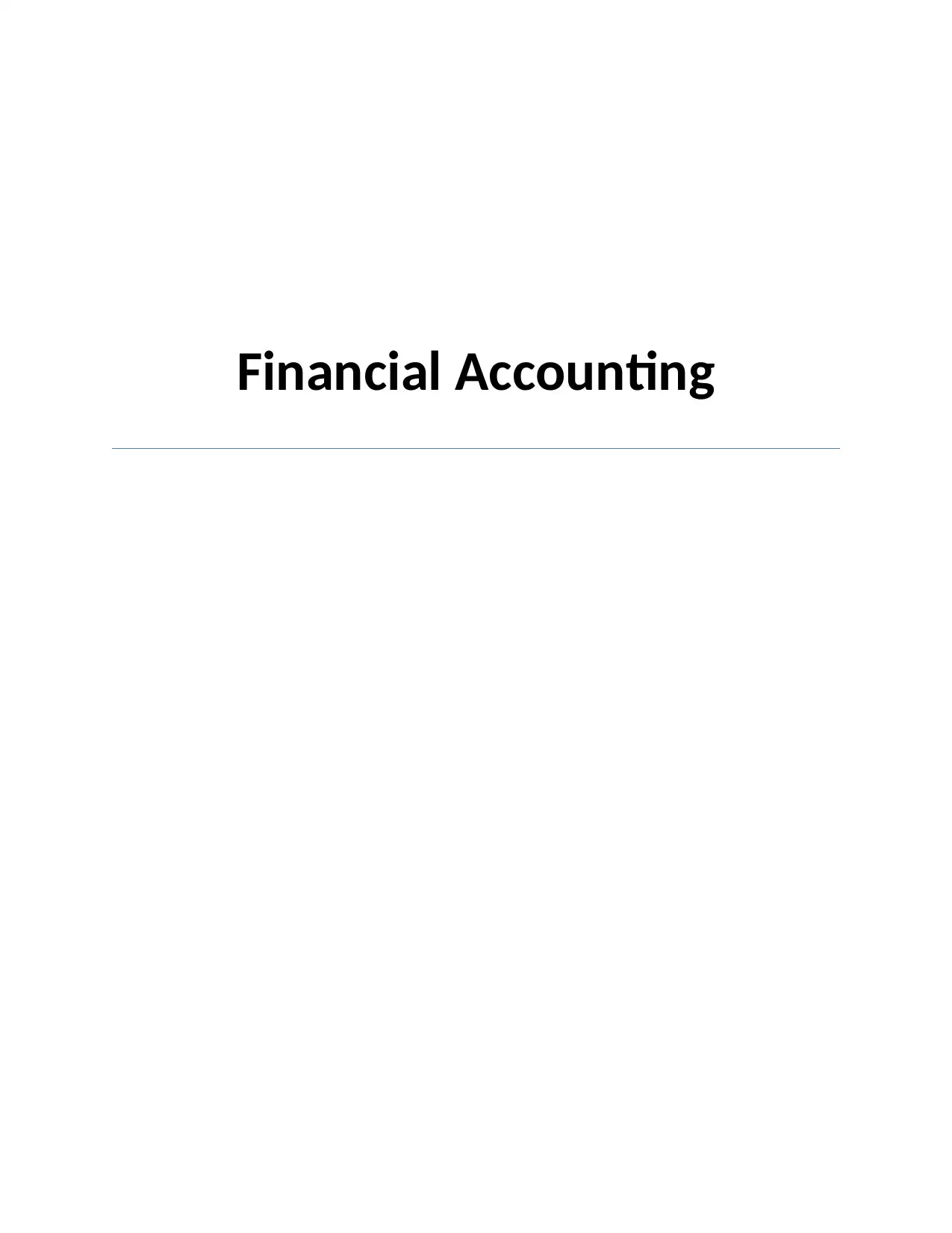
Financial Accounting
Paraphrase This Document
Need a fresh take? Get an instant paraphrase of this document with our AI Paraphraser
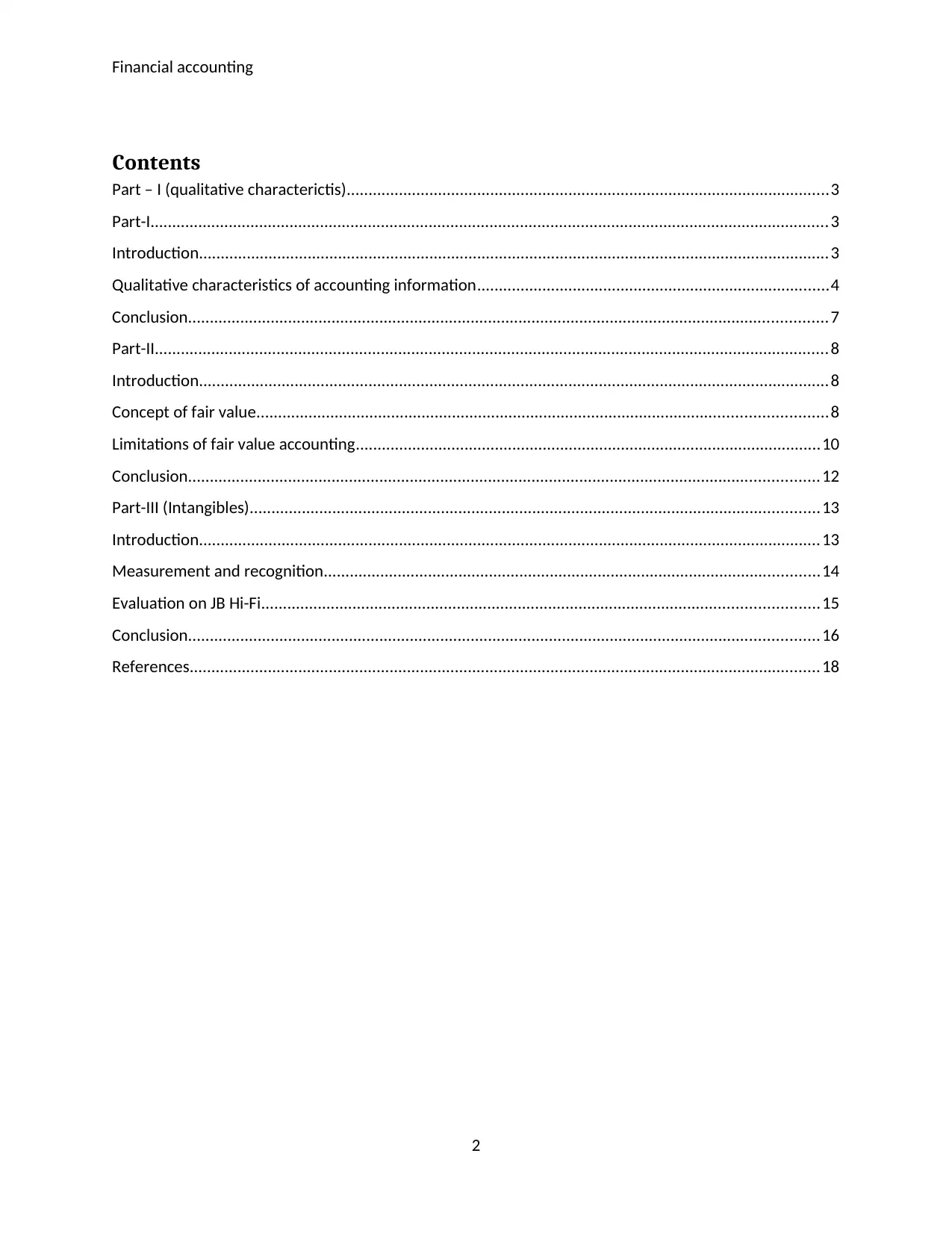
Financial accounting
Contents
Part – I (qualitative characterictis)...............................................................................................................3
Part-I............................................................................................................................................................3
Introduction.................................................................................................................................................3
Qualitative characteristics of accounting information.................................................................................4
Conclusion...................................................................................................................................................7
Part-II...........................................................................................................................................................8
Introduction.................................................................................................................................................8
Concept of fair value...................................................................................................................................8
Limitations of fair value accounting...........................................................................................................10
Conclusion.................................................................................................................................................12
Part-III (Intangibles)...................................................................................................................................13
Introduction...............................................................................................................................................13
Measurement and recognition..................................................................................................................14
Evaluation on JB Hi-Fi................................................................................................................................15
Conclusion.................................................................................................................................................16
References.................................................................................................................................................18
2
Contents
Part – I (qualitative characterictis)...............................................................................................................3
Part-I............................................................................................................................................................3
Introduction.................................................................................................................................................3
Qualitative characteristics of accounting information.................................................................................4
Conclusion...................................................................................................................................................7
Part-II...........................................................................................................................................................8
Introduction.................................................................................................................................................8
Concept of fair value...................................................................................................................................8
Limitations of fair value accounting...........................................................................................................10
Conclusion.................................................................................................................................................12
Part-III (Intangibles)...................................................................................................................................13
Introduction...............................................................................................................................................13
Measurement and recognition..................................................................................................................14
Evaluation on JB Hi-Fi................................................................................................................................15
Conclusion.................................................................................................................................................16
References.................................................................................................................................................18
2
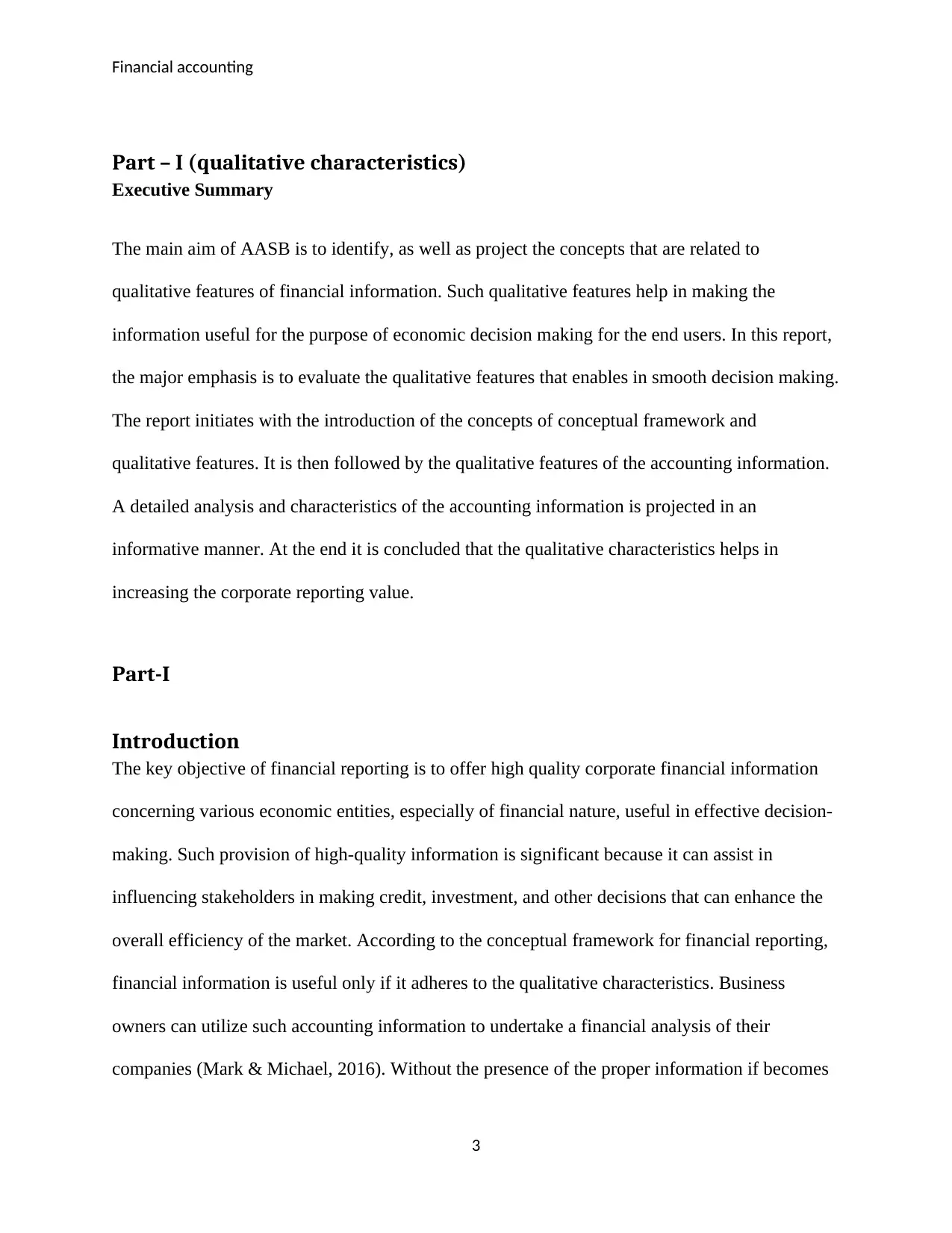
Financial accounting
Part – I (qualitative characteristics)
Executive Summary
The main aim of AASB is to identify, as well as project the concepts that are related to
qualitative features of financial information. Such qualitative features help in making the
information useful for the purpose of economic decision making for the end users. In this report,
the major emphasis is to evaluate the qualitative features that enables in smooth decision making.
The report initiates with the introduction of the concepts of conceptual framework and
qualitative features. It is then followed by the qualitative features of the accounting information.
A detailed analysis and characteristics of the accounting information is projected in an
informative manner. At the end it is concluded that the qualitative characteristics helps in
increasing the corporate reporting value.
Part-I
Introduction
The key objective of financial reporting is to offer high quality corporate financial information
concerning various economic entities, especially of financial nature, useful in effective decision-
making. Such provision of high-quality information is significant because it can assist in
influencing stakeholders in making credit, investment, and other decisions that can enhance the
overall efficiency of the market. According to the conceptual framework for financial reporting,
financial information is useful only if it adheres to the qualitative characteristics. Business
owners can utilize such accounting information to undertake a financial analysis of their
companies (Mark & Michael, 2016). Without the presence of the proper information if becomes
3
Part – I (qualitative characteristics)
Executive Summary
The main aim of AASB is to identify, as well as project the concepts that are related to
qualitative features of financial information. Such qualitative features help in making the
information useful for the purpose of economic decision making for the end users. In this report,
the major emphasis is to evaluate the qualitative features that enables in smooth decision making.
The report initiates with the introduction of the concepts of conceptual framework and
qualitative features. It is then followed by the qualitative features of the accounting information.
A detailed analysis and characteristics of the accounting information is projected in an
informative manner. At the end it is concluded that the qualitative characteristics helps in
increasing the corporate reporting value.
Part-I
Introduction
The key objective of financial reporting is to offer high quality corporate financial information
concerning various economic entities, especially of financial nature, useful in effective decision-
making. Such provision of high-quality information is significant because it can assist in
influencing stakeholders in making credit, investment, and other decisions that can enhance the
overall efficiency of the market. According to the conceptual framework for financial reporting,
financial information is useful only if it adheres to the qualitative characteristics. Business
owners can utilize such accounting information to undertake a financial analysis of their
companies (Mark & Michael, 2016). Without the presence of the proper information if becomes
3
⊘ This is a preview!⊘
Do you want full access?
Subscribe today to unlock all pages.

Trusted by 1+ million students worldwide
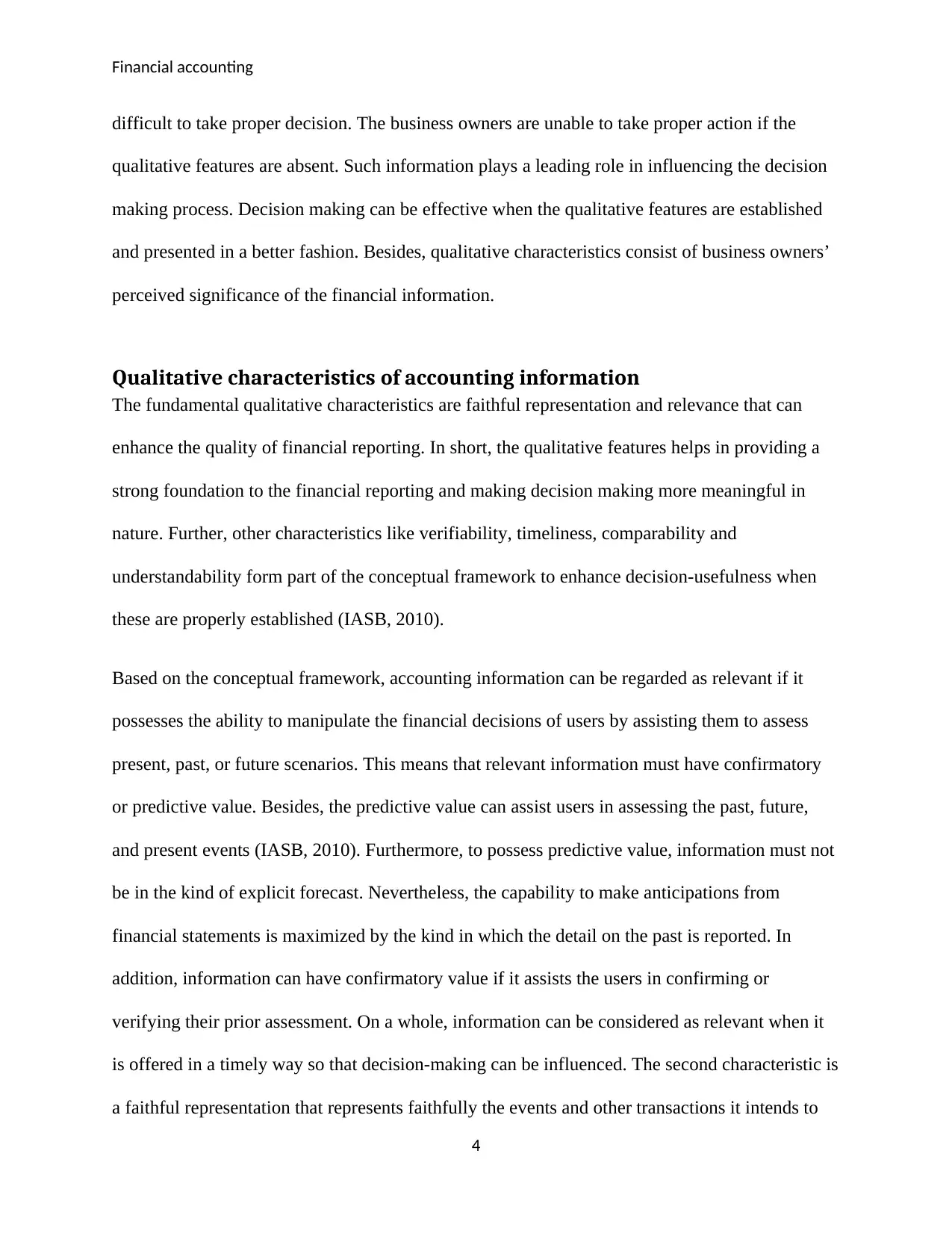
Financial accounting
difficult to take proper decision. The business owners are unable to take proper action if the
qualitative features are absent. Such information plays a leading role in influencing the decision
making process. Decision making can be effective when the qualitative features are established
and presented in a better fashion. Besides, qualitative characteristics consist of business owners’
perceived significance of the financial information.
Qualitative characteristics of accounting information
The fundamental qualitative characteristics are faithful representation and relevance that can
enhance the quality of financial reporting. In short, the qualitative features helps in providing a
strong foundation to the financial reporting and making decision making more meaningful in
nature. Further, other characteristics like verifiability, timeliness, comparability and
understandability form part of the conceptual framework to enhance decision-usefulness when
these are properly established (IASB, 2010).
Based on the conceptual framework, accounting information can be regarded as relevant if it
possesses the ability to manipulate the financial decisions of users by assisting them to assess
present, past, or future scenarios. This means that relevant information must have confirmatory
or predictive value. Besides, the predictive value can assist users in assessing the past, future,
and present events (IASB, 2010). Furthermore, to possess predictive value, information must not
be in the kind of explicit forecast. Nevertheless, the capability to make anticipations from
financial statements is maximized by the kind in which the detail on the past is reported. In
addition, information can have confirmatory value if it assists the users in confirming or
verifying their prior assessment. On a whole, information can be considered as relevant when it
is offered in a timely way so that decision-making can be influenced. The second characteristic is
a faithful representation that represents faithfully the events and other transactions it intends to
4
difficult to take proper decision. The business owners are unable to take proper action if the
qualitative features are absent. Such information plays a leading role in influencing the decision
making process. Decision making can be effective when the qualitative features are established
and presented in a better fashion. Besides, qualitative characteristics consist of business owners’
perceived significance of the financial information.
Qualitative characteristics of accounting information
The fundamental qualitative characteristics are faithful representation and relevance that can
enhance the quality of financial reporting. In short, the qualitative features helps in providing a
strong foundation to the financial reporting and making decision making more meaningful in
nature. Further, other characteristics like verifiability, timeliness, comparability and
understandability form part of the conceptual framework to enhance decision-usefulness when
these are properly established (IASB, 2010).
Based on the conceptual framework, accounting information can be regarded as relevant if it
possesses the ability to manipulate the financial decisions of users by assisting them to assess
present, past, or future scenarios. This means that relevant information must have confirmatory
or predictive value. Besides, the predictive value can assist users in assessing the past, future,
and present events (IASB, 2010). Furthermore, to possess predictive value, information must not
be in the kind of explicit forecast. Nevertheless, the capability to make anticipations from
financial statements is maximized by the kind in which the detail on the past is reported. In
addition, information can have confirmatory value if it assists the users in confirming or
verifying their prior assessment. On a whole, information can be considered as relevant when it
is offered in a timely way so that decision-making can be influenced. The second characteristic is
a faithful representation that represents faithfully the events and other transactions it intends to
4
Paraphrase This Document
Need a fresh take? Get an instant paraphrase of this document with our AI Paraphraser
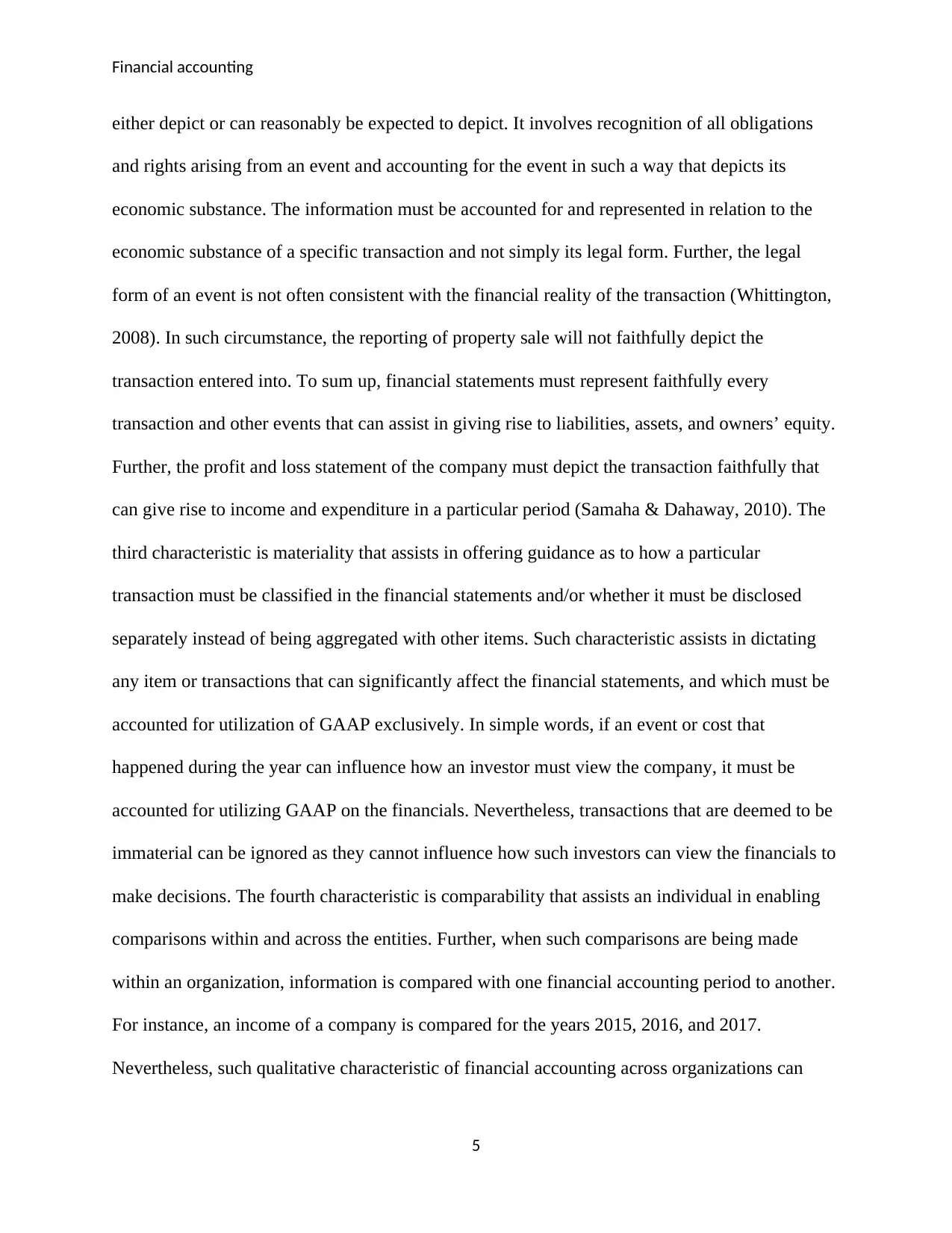
Financial accounting
either depict or can reasonably be expected to depict. It involves recognition of all obligations
and rights arising from an event and accounting for the event in such a way that depicts its
economic substance. The information must be accounted for and represented in relation to the
economic substance of a specific transaction and not simply its legal form. Further, the legal
form of an event is not often consistent with the financial reality of the transaction (Whittington,
2008). In such circumstance, the reporting of property sale will not faithfully depict the
transaction entered into. To sum up, financial statements must represent faithfully every
transaction and other events that can assist in giving rise to liabilities, assets, and owners’ equity.
Further, the profit and loss statement of the company must depict the transaction faithfully that
can give rise to income and expenditure in a particular period (Samaha & Dahaway, 2010). The
third characteristic is materiality that assists in offering guidance as to how a particular
transaction must be classified in the financial statements and/or whether it must be disclosed
separately instead of being aggregated with other items. Such characteristic assists in dictating
any item or transactions that can significantly affect the financial statements, and which must be
accounted for utilization of GAAP exclusively. In simple words, if an event or cost that
happened during the year can influence how an investor must view the company, it must be
accounted for utilizing GAAP on the financials. Nevertheless, transactions that are deemed to be
immaterial can be ignored as they cannot influence how such investors can view the financials to
make decisions. The fourth characteristic is comparability that assists an individual in enabling
comparisons within and across the entities. Further, when such comparisons are being made
within an organization, information is compared with one financial accounting period to another.
For instance, an income of a company is compared for the years 2015, 2016, and 2017.
Nevertheless, such qualitative characteristic of financial accounting across organizations can
5
either depict or can reasonably be expected to depict. It involves recognition of all obligations
and rights arising from an event and accounting for the event in such a way that depicts its
economic substance. The information must be accounted for and represented in relation to the
economic substance of a specific transaction and not simply its legal form. Further, the legal
form of an event is not often consistent with the financial reality of the transaction (Whittington,
2008). In such circumstance, the reporting of property sale will not faithfully depict the
transaction entered into. To sum up, financial statements must represent faithfully every
transaction and other events that can assist in giving rise to liabilities, assets, and owners’ equity.
Further, the profit and loss statement of the company must depict the transaction faithfully that
can give rise to income and expenditure in a particular period (Samaha & Dahaway, 2010). The
third characteristic is materiality that assists in offering guidance as to how a particular
transaction must be classified in the financial statements and/or whether it must be disclosed
separately instead of being aggregated with other items. Such characteristic assists in dictating
any item or transactions that can significantly affect the financial statements, and which must be
accounted for utilization of GAAP exclusively. In simple words, if an event or cost that
happened during the year can influence how an investor must view the company, it must be
accounted for utilizing GAAP on the financials. Nevertheless, transactions that are deemed to be
immaterial can be ignored as they cannot influence how such investors can view the financials to
make decisions. The fourth characteristic is comparability that assists an individual in enabling
comparisons within and across the entities. Further, when such comparisons are being made
within an organization, information is compared with one financial accounting period to another.
For instance, an income of a company is compared for the years 2015, 2016, and 2017.
Nevertheless, such qualitative characteristic of financial accounting across organizations can
5
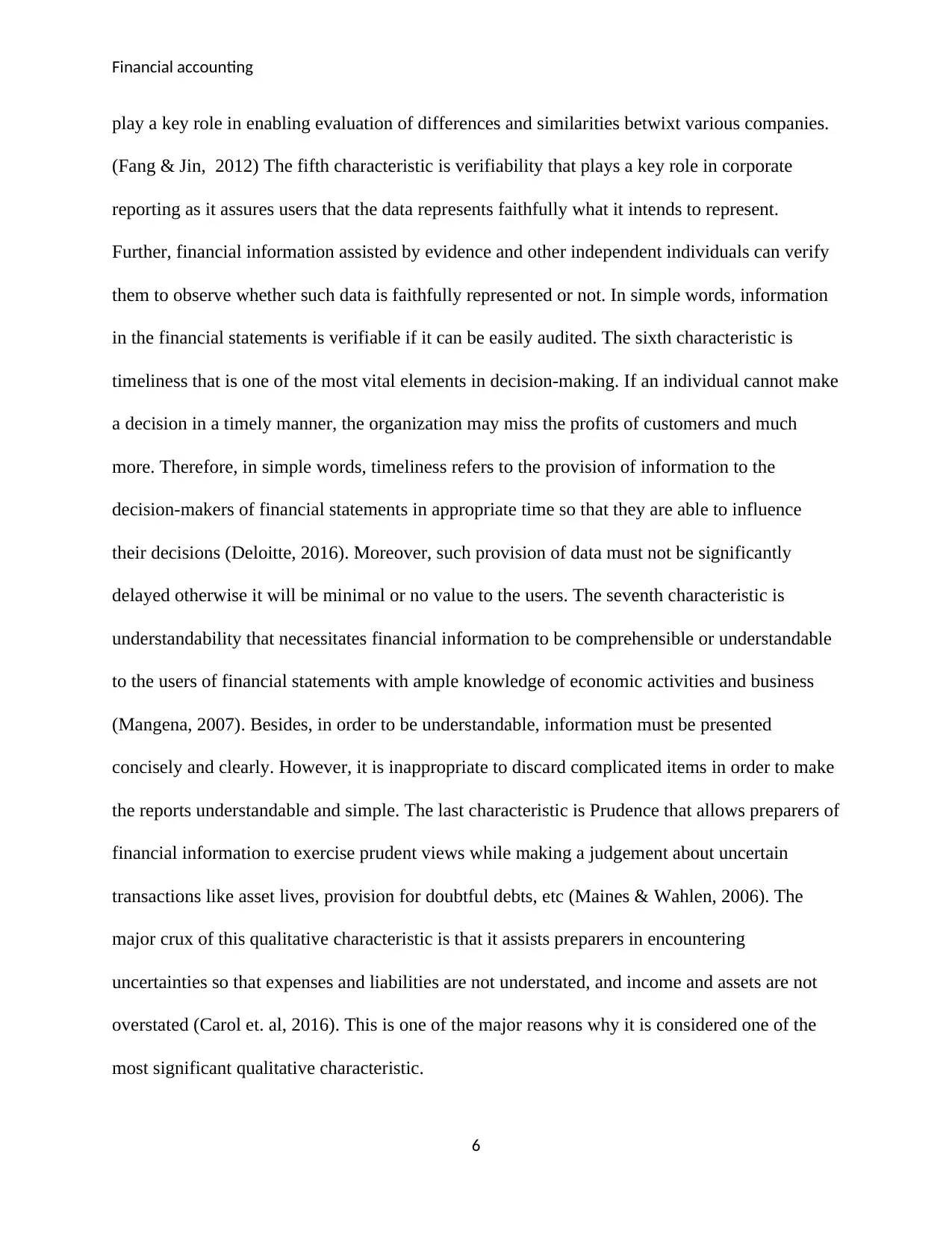
Financial accounting
play a key role in enabling evaluation of differences and similarities betwixt various companies.
(Fang & Jin, 2012) The fifth characteristic is verifiability that plays a key role in corporate
reporting as it assures users that the data represents faithfully what it intends to represent.
Further, financial information assisted by evidence and other independent individuals can verify
them to observe whether such data is faithfully represented or not. In simple words, information
in the financial statements is verifiable if it can be easily audited. The sixth characteristic is
timeliness that is one of the most vital elements in decision-making. If an individual cannot make
a decision in a timely manner, the organization may miss the profits of customers and much
more. Therefore, in simple words, timeliness refers to the provision of information to the
decision-makers of financial statements in appropriate time so that they are able to influence
their decisions (Deloitte, 2016). Moreover, such provision of data must not be significantly
delayed otherwise it will be minimal or no value to the users. The seventh characteristic is
understandability that necessitates financial information to be comprehensible or understandable
to the users of financial statements with ample knowledge of economic activities and business
(Mangena, 2007). Besides, in order to be understandable, information must be presented
concisely and clearly. However, it is inappropriate to discard complicated items in order to make
the reports understandable and simple. The last characteristic is Prudence that allows preparers of
financial information to exercise prudent views while making a judgement about uncertain
transactions like asset lives, provision for doubtful debts, etc (Maines & Wahlen, 2006). The
major crux of this qualitative characteristic is that it assists preparers in encountering
uncertainties so that expenses and liabilities are not understated, and income and assets are not
overstated (Carol et. al, 2016). This is one of the major reasons why it is considered one of the
most significant qualitative characteristic.
6
play a key role in enabling evaluation of differences and similarities betwixt various companies.
(Fang & Jin, 2012) The fifth characteristic is verifiability that plays a key role in corporate
reporting as it assures users that the data represents faithfully what it intends to represent.
Further, financial information assisted by evidence and other independent individuals can verify
them to observe whether such data is faithfully represented or not. In simple words, information
in the financial statements is verifiable if it can be easily audited. The sixth characteristic is
timeliness that is one of the most vital elements in decision-making. If an individual cannot make
a decision in a timely manner, the organization may miss the profits of customers and much
more. Therefore, in simple words, timeliness refers to the provision of information to the
decision-makers of financial statements in appropriate time so that they are able to influence
their decisions (Deloitte, 2016). Moreover, such provision of data must not be significantly
delayed otherwise it will be minimal or no value to the users. The seventh characteristic is
understandability that necessitates financial information to be comprehensible or understandable
to the users of financial statements with ample knowledge of economic activities and business
(Mangena, 2007). Besides, in order to be understandable, information must be presented
concisely and clearly. However, it is inappropriate to discard complicated items in order to make
the reports understandable and simple. The last characteristic is Prudence that allows preparers of
financial information to exercise prudent views while making a judgement about uncertain
transactions like asset lives, provision for doubtful debts, etc (Maines & Wahlen, 2006). The
major crux of this qualitative characteristic is that it assists preparers in encountering
uncertainties so that expenses and liabilities are not understated, and income and assets are not
overstated (Carol et. al, 2016). This is one of the major reasons why it is considered one of the
most significant qualitative characteristic.
6
⊘ This is a preview!⊘
Do you want full access?
Subscribe today to unlock all pages.

Trusted by 1+ million students worldwide
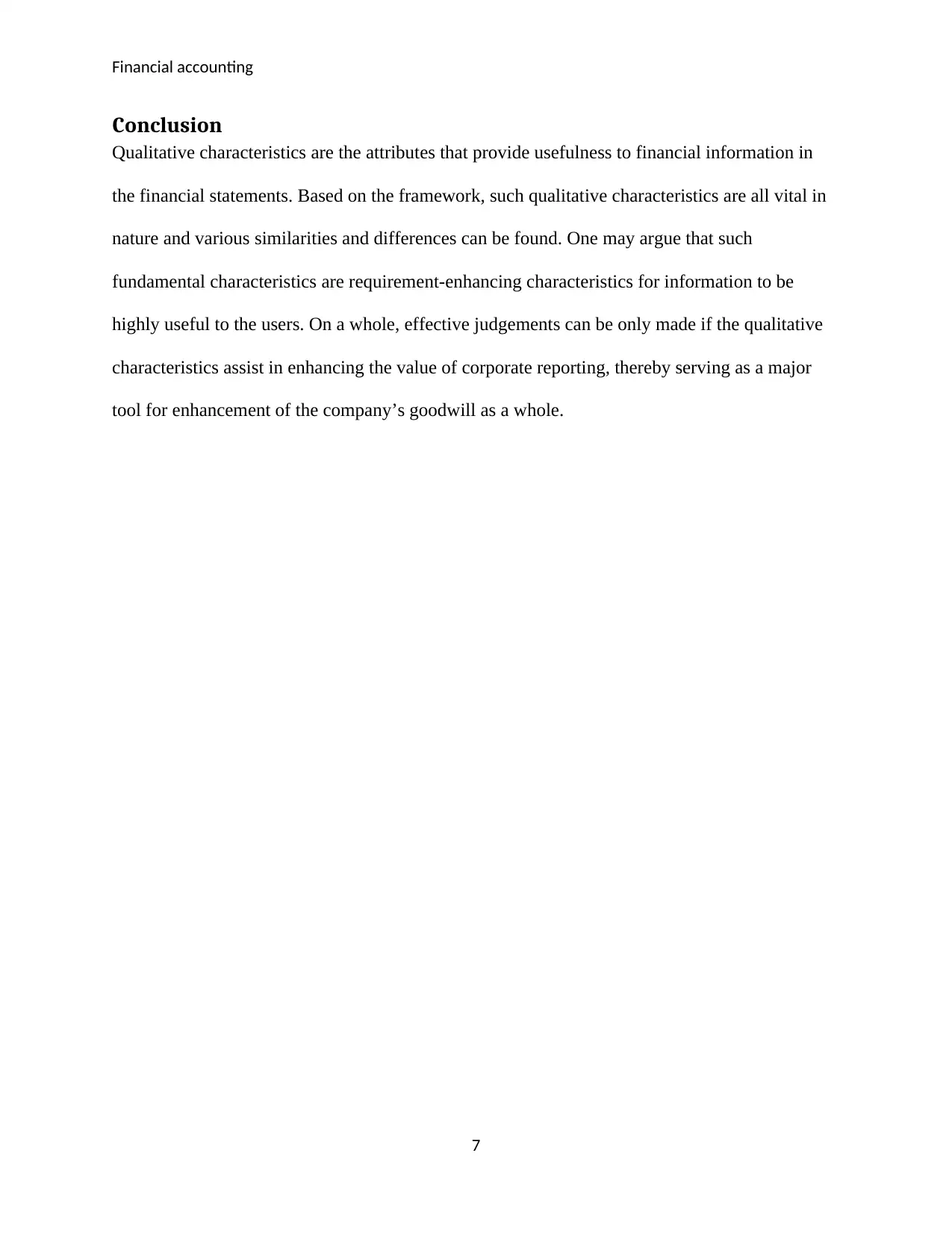
Financial accounting
Conclusion
Qualitative characteristics are the attributes that provide usefulness to financial information in
the financial statements. Based on the framework, such qualitative characteristics are all vital in
nature and various similarities and differences can be found. One may argue that such
fundamental characteristics are requirement-enhancing characteristics for information to be
highly useful to the users. On a whole, effective judgements can be only made if the qualitative
characteristics assist in enhancing the value of corporate reporting, thereby serving as a major
tool for enhancement of the company’s goodwill as a whole.
7
Conclusion
Qualitative characteristics are the attributes that provide usefulness to financial information in
the financial statements. Based on the framework, such qualitative characteristics are all vital in
nature and various similarities and differences can be found. One may argue that such
fundamental characteristics are requirement-enhancing characteristics for information to be
highly useful to the users. On a whole, effective judgements can be only made if the qualitative
characteristics assist in enhancing the value of corporate reporting, thereby serving as a major
tool for enhancement of the company’s goodwill as a whole.
7
Paraphrase This Document
Need a fresh take? Get an instant paraphrase of this document with our AI Paraphraser
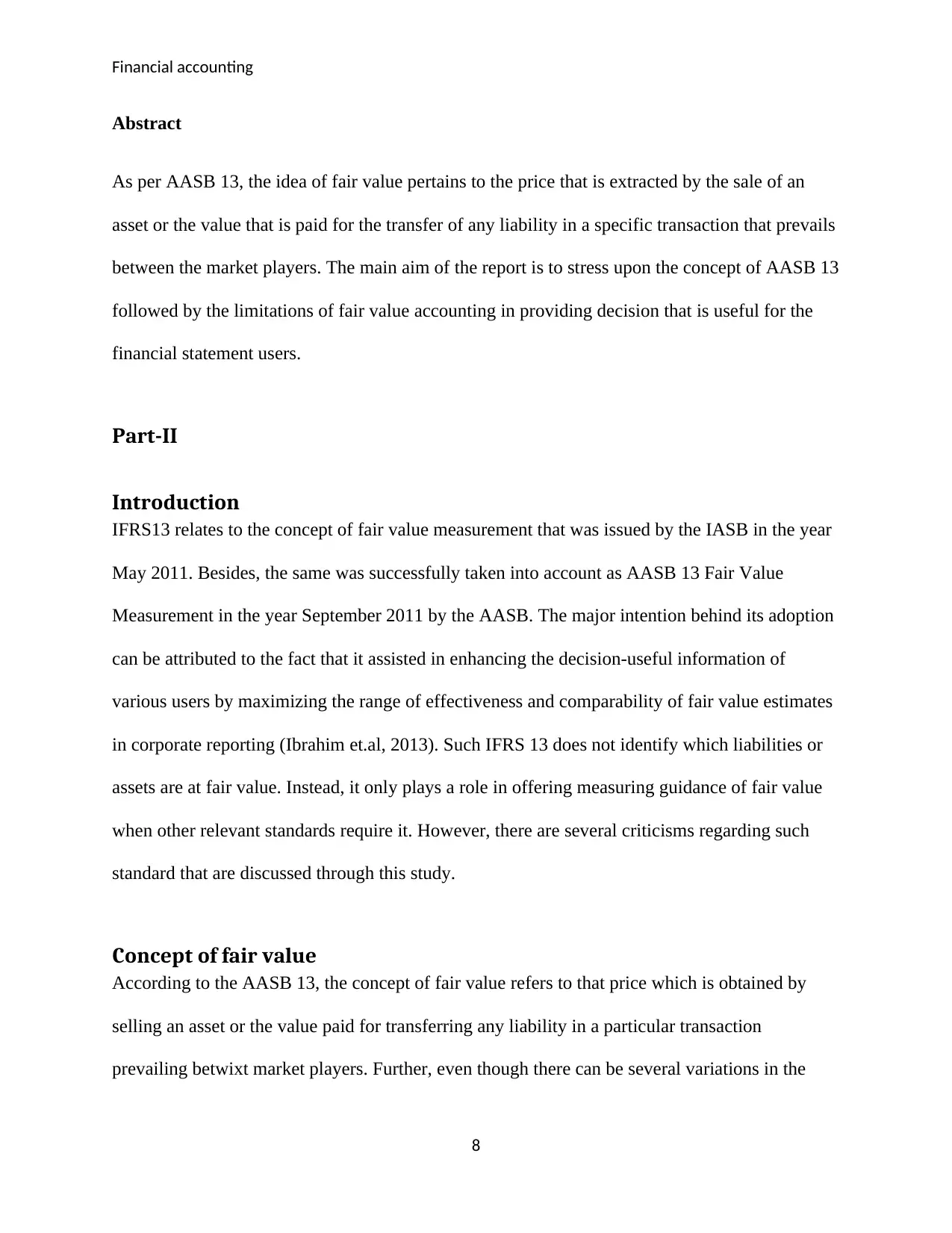
Financial accounting
Abstract
As per AASB 13, the idea of fair value pertains to the price that is extracted by the sale of an
asset or the value that is paid for the transfer of any liability in a specific transaction that prevails
between the market players. The main aim of the report is to stress upon the concept of AASB 13
followed by the limitations of fair value accounting in providing decision that is useful for the
financial statement users.
Part-II
Introduction
IFRS13 relates to the concept of fair value measurement that was issued by the IASB in the year
May 2011. Besides, the same was successfully taken into account as AASB 13 Fair Value
Measurement in the year September 2011 by the AASB. The major intention behind its adoption
can be attributed to the fact that it assisted in enhancing the decision-useful information of
various users by maximizing the range of effectiveness and comparability of fair value estimates
in corporate reporting (Ibrahim et.al, 2013). Such IFRS 13 does not identify which liabilities or
assets are at fair value. Instead, it only plays a role in offering measuring guidance of fair value
when other relevant standards require it. However, there are several criticisms regarding such
standard that are discussed through this study.
Concept of fair value
According to the AASB 13, the concept of fair value refers to that price which is obtained by
selling an asset or the value paid for transferring any liability in a particular transaction
prevailing betwixt market players. Further, even though there can be several variations in the
8
Abstract
As per AASB 13, the idea of fair value pertains to the price that is extracted by the sale of an
asset or the value that is paid for the transfer of any liability in a specific transaction that prevails
between the market players. The main aim of the report is to stress upon the concept of AASB 13
followed by the limitations of fair value accounting in providing decision that is useful for the
financial statement users.
Part-II
Introduction
IFRS13 relates to the concept of fair value measurement that was issued by the IASB in the year
May 2011. Besides, the same was successfully taken into account as AASB 13 Fair Value
Measurement in the year September 2011 by the AASB. The major intention behind its adoption
can be attributed to the fact that it assisted in enhancing the decision-useful information of
various users by maximizing the range of effectiveness and comparability of fair value estimates
in corporate reporting (Ibrahim et.al, 2013). Such IFRS 13 does not identify which liabilities or
assets are at fair value. Instead, it only plays a role in offering measuring guidance of fair value
when other relevant standards require it. However, there are several criticisms regarding such
standard that are discussed through this study.
Concept of fair value
According to the AASB 13, the concept of fair value refers to that price which is obtained by
selling an asset or the value paid for transferring any liability in a particular transaction
prevailing betwixt market players. Further, even though there can be several variations in the
8
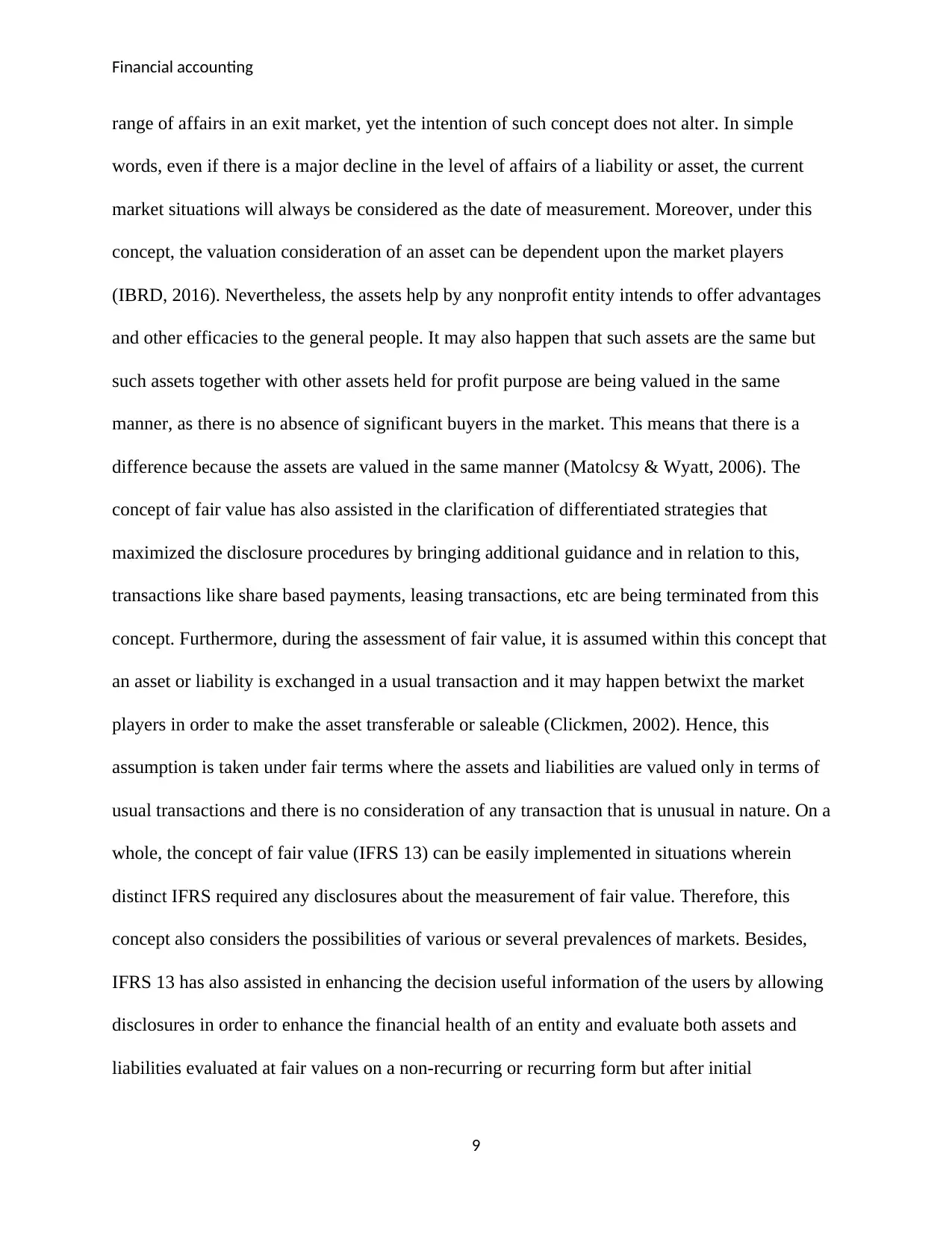
Financial accounting
range of affairs in an exit market, yet the intention of such concept does not alter. In simple
words, even if there is a major decline in the level of affairs of a liability or asset, the current
market situations will always be considered as the date of measurement. Moreover, under this
concept, the valuation consideration of an asset can be dependent upon the market players
(IBRD, 2016). Nevertheless, the assets help by any nonprofit entity intends to offer advantages
and other efficacies to the general people. It may also happen that such assets are the same but
such assets together with other assets held for profit purpose are being valued in the same
manner, as there is no absence of significant buyers in the market. This means that there is a
difference because the assets are valued in the same manner (Matolcsy & Wyatt, 2006). The
concept of fair value has also assisted in the clarification of differentiated strategies that
maximized the disclosure procedures by bringing additional guidance and in relation to this,
transactions like share based payments, leasing transactions, etc are being terminated from this
concept. Furthermore, during the assessment of fair value, it is assumed within this concept that
an asset or liability is exchanged in a usual transaction and it may happen betwixt the market
players in order to make the asset transferable or saleable (Clickmen, 2002). Hence, this
assumption is taken under fair terms where the assets and liabilities are valued only in terms of
usual transactions and there is no consideration of any transaction that is unusual in nature. On a
whole, the concept of fair value (IFRS 13) can be easily implemented in situations wherein
distinct IFRS required any disclosures about the measurement of fair value. Therefore, this
concept also considers the possibilities of various or several prevalences of markets. Besides,
IFRS 13 has also assisted in enhancing the decision useful information of the users by allowing
disclosures in order to enhance the financial health of an entity and evaluate both assets and
liabilities evaluated at fair values on a non-recurring or recurring form but after initial
9
range of affairs in an exit market, yet the intention of such concept does not alter. In simple
words, even if there is a major decline in the level of affairs of a liability or asset, the current
market situations will always be considered as the date of measurement. Moreover, under this
concept, the valuation consideration of an asset can be dependent upon the market players
(IBRD, 2016). Nevertheless, the assets help by any nonprofit entity intends to offer advantages
and other efficacies to the general people. It may also happen that such assets are the same but
such assets together with other assets held for profit purpose are being valued in the same
manner, as there is no absence of significant buyers in the market. This means that there is a
difference because the assets are valued in the same manner (Matolcsy & Wyatt, 2006). The
concept of fair value has also assisted in the clarification of differentiated strategies that
maximized the disclosure procedures by bringing additional guidance and in relation to this,
transactions like share based payments, leasing transactions, etc are being terminated from this
concept. Furthermore, during the assessment of fair value, it is assumed within this concept that
an asset or liability is exchanged in a usual transaction and it may happen betwixt the market
players in order to make the asset transferable or saleable (Clickmen, 2002). Hence, this
assumption is taken under fair terms where the assets and liabilities are valued only in terms of
usual transactions and there is no consideration of any transaction that is unusual in nature. On a
whole, the concept of fair value (IFRS 13) can be easily implemented in situations wherein
distinct IFRS required any disclosures about the measurement of fair value. Therefore, this
concept also considers the possibilities of various or several prevalences of markets. Besides,
IFRS 13 has also assisted in enhancing the decision useful information of the users by allowing
disclosures in order to enhance the financial health of an entity and evaluate both assets and
liabilities evaluated at fair values on a non-recurring or recurring form but after initial
9
⊘ This is a preview!⊘
Do you want full access?
Subscribe today to unlock all pages.

Trusted by 1+ million students worldwide
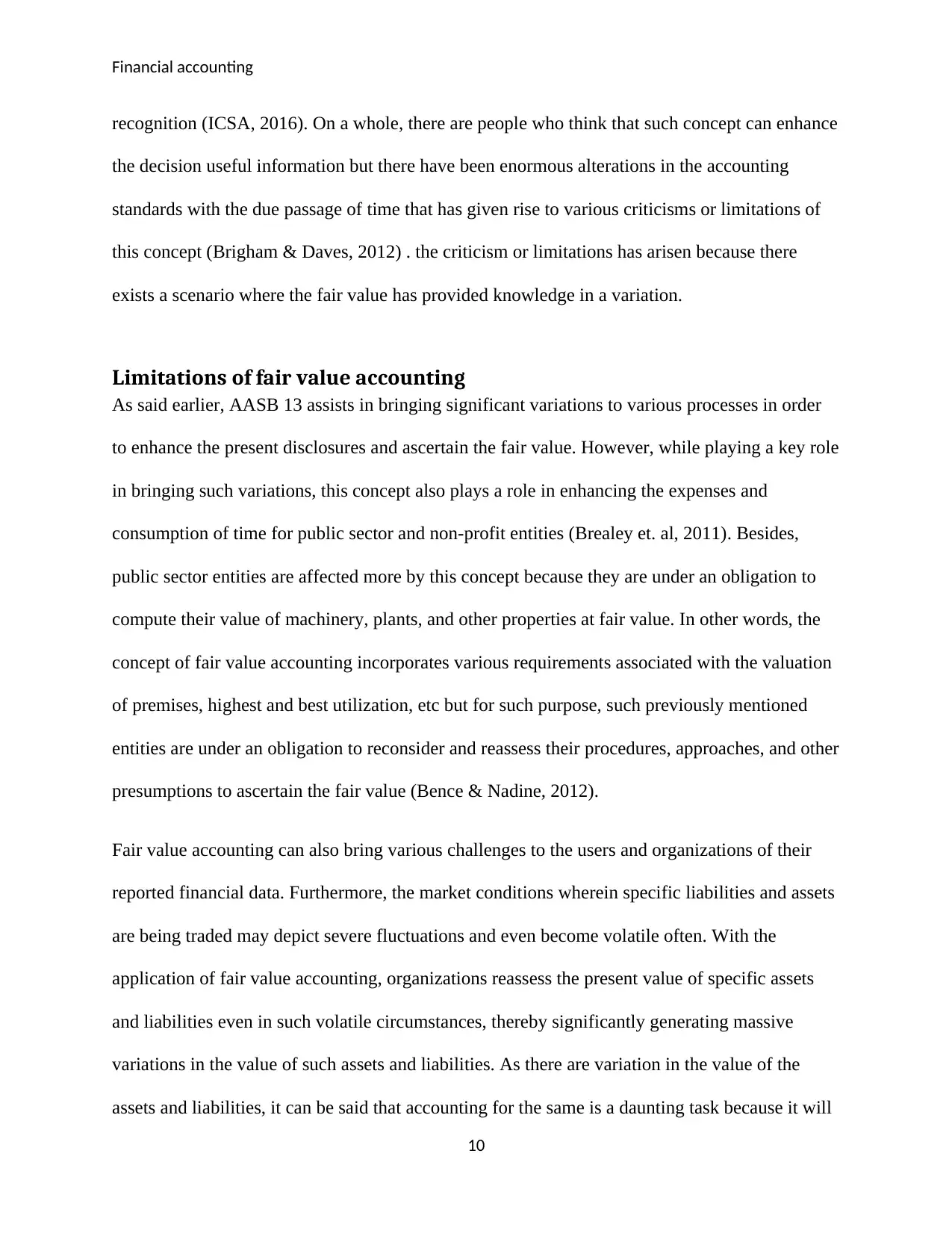
Financial accounting
recognition (ICSA, 2016). On a whole, there are people who think that such concept can enhance
the decision useful information but there have been enormous alterations in the accounting
standards with the due passage of time that has given rise to various criticisms or limitations of
this concept (Brigham & Daves, 2012) . the criticism or limitations has arisen because there
exists a scenario where the fair value has provided knowledge in a variation.
Limitations of fair value accounting
As said earlier, AASB 13 assists in bringing significant variations to various processes in order
to enhance the present disclosures and ascertain the fair value. However, while playing a key role
in bringing such variations, this concept also plays a role in enhancing the expenses and
consumption of time for public sector and non-profit entities (Brealey et. al, 2011). Besides,
public sector entities are affected more by this concept because they are under an obligation to
compute their value of machinery, plants, and other properties at fair value. In other words, the
concept of fair value accounting incorporates various requirements associated with the valuation
of premises, highest and best utilization, etc but for such purpose, such previously mentioned
entities are under an obligation to reconsider and reassess their procedures, approaches, and other
presumptions to ascertain the fair value (Bence & Nadine, 2012).
Fair value accounting can also bring various challenges to the users and organizations of their
reported financial data. Furthermore, the market conditions wherein specific liabilities and assets
are being traded may depict severe fluctuations and even become volatile often. With the
application of fair value accounting, organizations reassess the present value of specific assets
and liabilities even in such volatile circumstances, thereby significantly generating massive
variations in the value of such assets and liabilities. As there are variation in the value of the
assets and liabilities, it can be said that accounting for the same is a daunting task because it will
10
recognition (ICSA, 2016). On a whole, there are people who think that such concept can enhance
the decision useful information but there have been enormous alterations in the accounting
standards with the due passage of time that has given rise to various criticisms or limitations of
this concept (Brigham & Daves, 2012) . the criticism or limitations has arisen because there
exists a scenario where the fair value has provided knowledge in a variation.
Limitations of fair value accounting
As said earlier, AASB 13 assists in bringing significant variations to various processes in order
to enhance the present disclosures and ascertain the fair value. However, while playing a key role
in bringing such variations, this concept also plays a role in enhancing the expenses and
consumption of time for public sector and non-profit entities (Brealey et. al, 2011). Besides,
public sector entities are affected more by this concept because they are under an obligation to
compute their value of machinery, plants, and other properties at fair value. In other words, the
concept of fair value accounting incorporates various requirements associated with the valuation
of premises, highest and best utilization, etc but for such purpose, such previously mentioned
entities are under an obligation to reconsider and reassess their procedures, approaches, and other
presumptions to ascertain the fair value (Bence & Nadine, 2012).
Fair value accounting can also bring various challenges to the users and organizations of their
reported financial data. Furthermore, the market conditions wherein specific liabilities and assets
are being traded may depict severe fluctuations and even become volatile often. With the
application of fair value accounting, organizations reassess the present value of specific assets
and liabilities even in such volatile circumstances, thereby significantly generating massive
variations in the value of such assets and liabilities. As there are variation in the value of the
assets and liabilities, it can be said that accounting for the same is a daunting task because it will
10
Paraphrase This Document
Need a fresh take? Get an instant paraphrase of this document with our AI Paraphraser
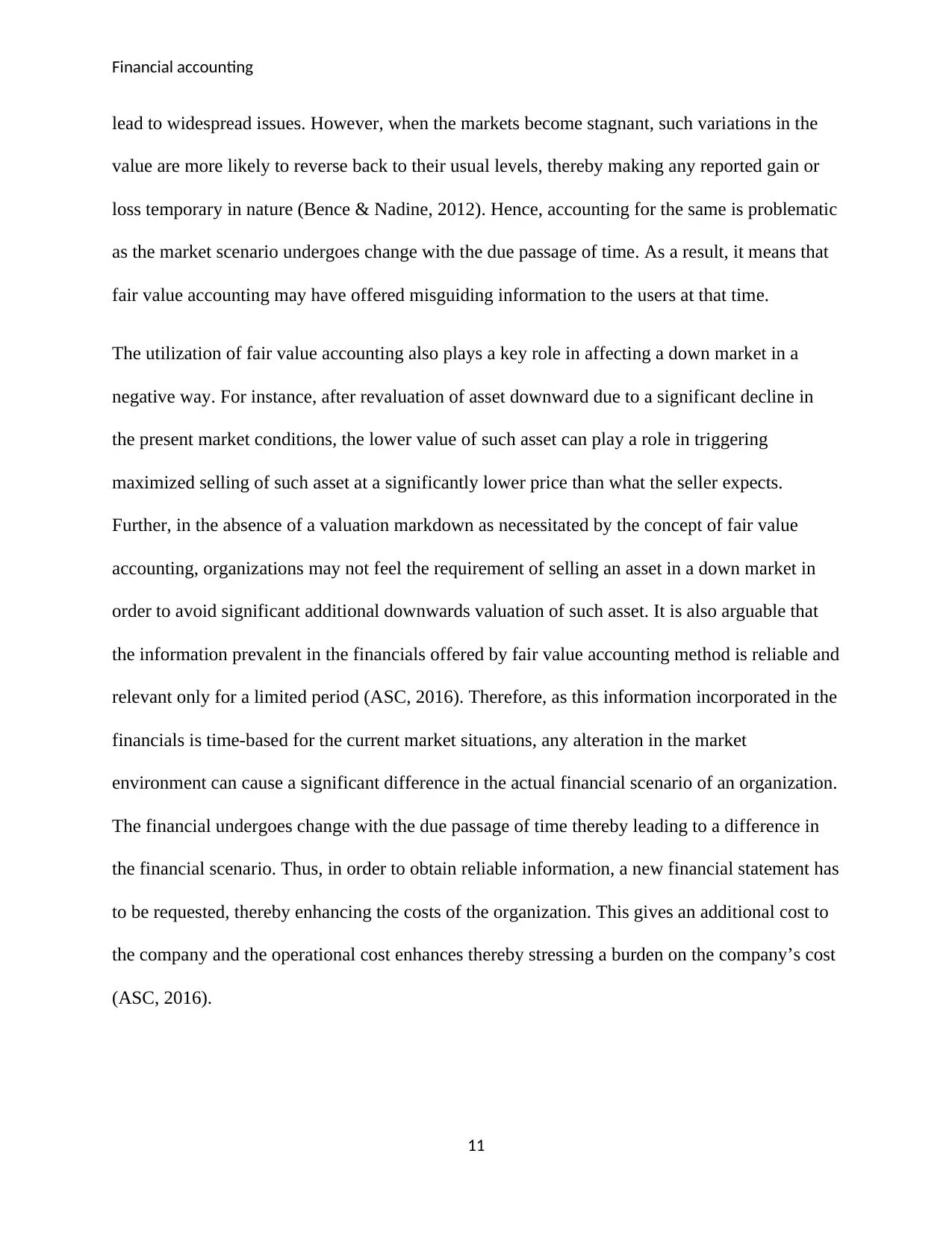
Financial accounting
lead to widespread issues. However, when the markets become stagnant, such variations in the
value are more likely to reverse back to their usual levels, thereby making any reported gain or
loss temporary in nature (Bence & Nadine, 2012). Hence, accounting for the same is problematic
as the market scenario undergoes change with the due passage of time. As a result, it means that
fair value accounting may have offered misguiding information to the users at that time.
The utilization of fair value accounting also plays a key role in affecting a down market in a
negative way. For instance, after revaluation of asset downward due to a significant decline in
the present market conditions, the lower value of such asset can play a role in triggering
maximized selling of such asset at a significantly lower price than what the seller expects.
Further, in the absence of a valuation markdown as necessitated by the concept of fair value
accounting, organizations may not feel the requirement of selling an asset in a down market in
order to avoid significant additional downwards valuation of such asset. It is also arguable that
the information prevalent in the financials offered by fair value accounting method is reliable and
relevant only for a limited period (ASC, 2016). Therefore, as this information incorporated in the
financials is time-based for the current market situations, any alteration in the market
environment can cause a significant difference in the actual financial scenario of an organization.
The financial undergoes change with the due passage of time thereby leading to a difference in
the financial scenario. Thus, in order to obtain reliable information, a new financial statement has
to be requested, thereby enhancing the costs of the organization. This gives an additional cost to
the company and the operational cost enhances thereby stressing a burden on the company’s cost
(ASC, 2016).
11
lead to widespread issues. However, when the markets become stagnant, such variations in the
value are more likely to reverse back to their usual levels, thereby making any reported gain or
loss temporary in nature (Bence & Nadine, 2012). Hence, accounting for the same is problematic
as the market scenario undergoes change with the due passage of time. As a result, it means that
fair value accounting may have offered misguiding information to the users at that time.
The utilization of fair value accounting also plays a key role in affecting a down market in a
negative way. For instance, after revaluation of asset downward due to a significant decline in
the present market conditions, the lower value of such asset can play a role in triggering
maximized selling of such asset at a significantly lower price than what the seller expects.
Further, in the absence of a valuation markdown as necessitated by the concept of fair value
accounting, organizations may not feel the requirement of selling an asset in a down market in
order to avoid significant additional downwards valuation of such asset. It is also arguable that
the information prevalent in the financials offered by fair value accounting method is reliable and
relevant only for a limited period (ASC, 2016). Therefore, as this information incorporated in the
financials is time-based for the current market situations, any alteration in the market
environment can cause a significant difference in the actual financial scenario of an organization.
The financial undergoes change with the due passage of time thereby leading to a difference in
the financial scenario. Thus, in order to obtain reliable information, a new financial statement has
to be requested, thereby enhancing the costs of the organization. This gives an additional cost to
the company and the operational cost enhances thereby stressing a burden on the company’s cost
(ASC, 2016).
11
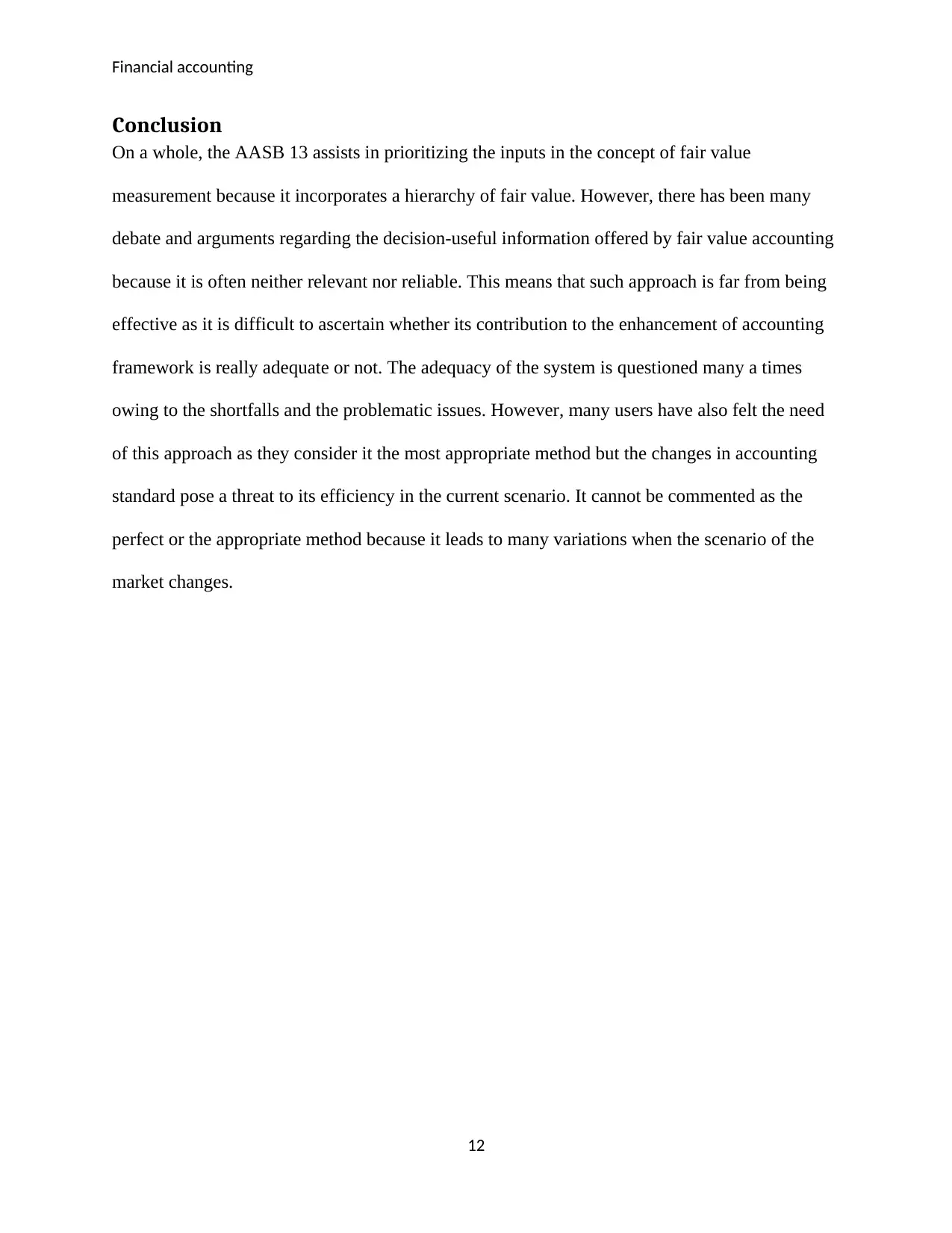
Financial accounting
Conclusion
On a whole, the AASB 13 assists in prioritizing the inputs in the concept of fair value
measurement because it incorporates a hierarchy of fair value. However, there has been many
debate and arguments regarding the decision-useful information offered by fair value accounting
because it is often neither relevant nor reliable. This means that such approach is far from being
effective as it is difficult to ascertain whether its contribution to the enhancement of accounting
framework is really adequate or not. The adequacy of the system is questioned many a times
owing to the shortfalls and the problematic issues. However, many users have also felt the need
of this approach as they consider it the most appropriate method but the changes in accounting
standard pose a threat to its efficiency in the current scenario. It cannot be commented as the
perfect or the appropriate method because it leads to many variations when the scenario of the
market changes.
12
Conclusion
On a whole, the AASB 13 assists in prioritizing the inputs in the concept of fair value
measurement because it incorporates a hierarchy of fair value. However, there has been many
debate and arguments regarding the decision-useful information offered by fair value accounting
because it is often neither relevant nor reliable. This means that such approach is far from being
effective as it is difficult to ascertain whether its contribution to the enhancement of accounting
framework is really adequate or not. The adequacy of the system is questioned many a times
owing to the shortfalls and the problematic issues. However, many users have also felt the need
of this approach as they consider it the most appropriate method but the changes in accounting
standard pose a threat to its efficiency in the current scenario. It cannot be commented as the
perfect or the appropriate method because it leads to many variations when the scenario of the
market changes.
12
⊘ This is a preview!⊘
Do you want full access?
Subscribe today to unlock all pages.

Trusted by 1+ million students worldwide
1 out of 20
Related Documents
Your All-in-One AI-Powered Toolkit for Academic Success.
+13062052269
info@desklib.com
Available 24*7 on WhatsApp / Email
![[object Object]](/_next/static/media/star-bottom.7253800d.svg)
Unlock your academic potential
Copyright © 2020–2025 A2Z Services. All Rights Reserved. Developed and managed by ZUCOL.





